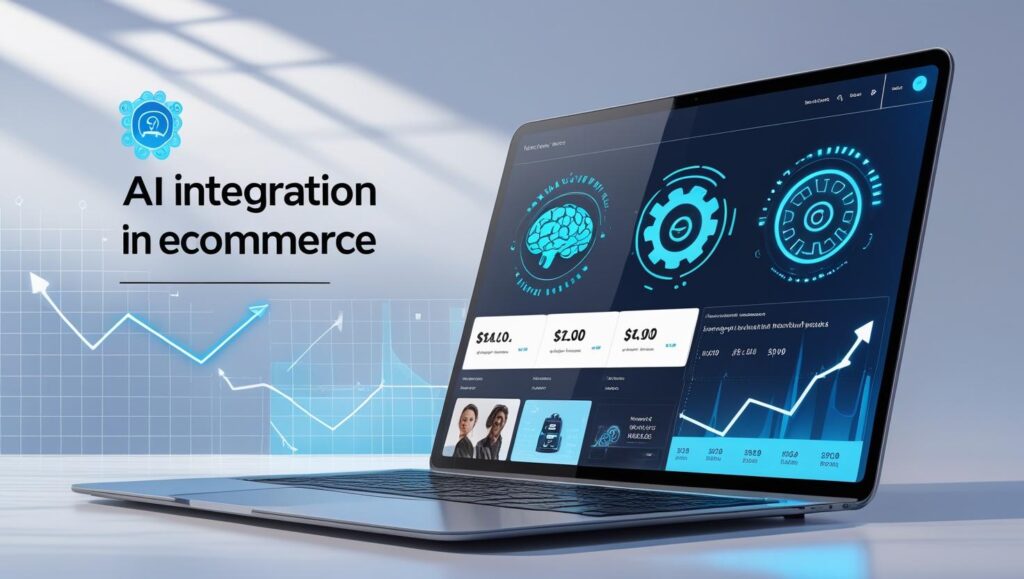E-commerce has helped businesses by helping them reach global consumers with just a single click. The introduction of AI in e-commerce has completely changed the way online businesses operate by leveling up efficiency, innovation, and customer experience.
AI has enormous potential for everything from inventory management to suggesting personalized products. But these potentials also bring with them practical difficulties that companies need to handle carefully.

In this article, we will explore the enormous role of AI in eCommerce, highlighting the opportunities and challenges present and faced.
Opportunities: AI Revolution in eCommerce
- Hyper-Personalized Shopping Experience
Competition is high, and customer demand has increased. Customers now demand more than just a transaction and exchange– they want a carefully organized and managed experience.
AI provides just that by tracking and analysing user behaviour, their purchase history, demographics, and even real-time behaviour to personalize product recommendations.
Example: –
A customer who just bought travel accessories will be recommended travel-sized essentials. Platforms like Amazon and Noon excel at this.
- Smarter Search and Voice Commerce
AI has replaced the endless scroll in the search for a specific product with natural language search and image-based search. Customers can now even use voice assistants like Alexa or Google Assistant to help them find what they are looking for!
Example: –
The customer takes a reference photo of a shirt they’re looking for and uses AI, which leads them to stores with similar or exact style and colour.
- 24/7 AI Chatbots for Customer Support
AI-powered chatbots can immediately respond to thousands of consumer inquiries, including purchase monitoring and return processing.
They reduce human workload, have faster response times, and can work 24/7 without getting tired.
Example: –
AI-powered chatbots are used by big brands like H&M to assist consumers with queries, purchases, and searches.
Some chatbots, like Tidio or Drift, even improve their responses by learning from past conversations.
- Predictive Analytics and Dynamic Pricing
AI can predict future trends by analysing current trends and demands of consumers, like what will be in demand next, or which regions show growth potential.
In addition to this, businesses can now automatically modify prices in response to demand, seasonality, inventory levels, rival pricing, and consumer segments, all thanks to AI.
Example: –
Many retail stores like Walmart, Target, and eBay would use AI to adjust prices based on market trends, competitive pricing, and demand.
- Inventory and Supply Chain Optimization
AI is beneficial in keeping track of inventory needs and restocking. It also helps to detect any disruption in the supply chain early. Financially, this is a great method as it prevents over- or understocking and overall improves efficiency.
Example: –
AI is used by platforms such as ClearMetal and Llamasoft to provide real-time insights into logistics and inventory management.
- Fraud Detection and Cybersecurity
Detecting and preventing fraud is crucial for an e-commerce business. Machine learning models help with just that by analyzing transaction data to spot unusual behaviour, like mismatched locations and several failed transactions.
Along with this, it can also identify fake reviews and flag suspicious accounts.
Challenges: Real Hurdles in AI Adoption
Though the benefits of AI in eCommerce are a lot. Businesses still go through many challenges while integrating AI into their work.
- Data Privacy and Ethical Concerns
To get any work done, AI requires data. And AI collecting, storing, and analysing user data raises serious concerns since any mistake while handling the data can lead to bad consequences.
Due to this, the user may sue or take legal action against the company, which could severely damage the company’s reputation, affecting their sales.
Important regulations to consider are: –
- GDPR (Europe)
- CCPA (California)
- PECA (Pakistan)
It is also very important that you give insight to the user about how and where their personal information will be used.
- High Development and Maintenance Costs
Integrating AI can be very expensive, especially for new or small businesses with a limited financial budget and limited resources.
AI implementations require: –
- AI professional
- Large datasets
- Advanced infrastructures
- Constant monitoring and updates
- Implementing AI in an already existing system
The cost of these requirements can be very substantial for a business, especially for a startup.
Solution: –
Make use of plug-and-play AI solutions like Google Cloud AI, Shopify’s AI integrations, or ready-made ML APIs that need little configuration.
- Integration with Older Systems
Older and outdated sites and systems were not designed with AI in mind. And so, integrating AI into these systems can raise compatibility issues during the adoption process, creating friction.
Solution: –
Start with modular AI integrations that complement your current tech stack, such as recommendation engines or chatbots.
- Over-Automation and Loss of Human Touch
While AI and automation may save money, time, and human labour, users still prefer humans over AI when it comes to complaints and suggestions, since AI can come off as cold and rather direct.
Humans can easily get overstimulated and stressed, and personal interaction plays a crucial role in handling such situations because AI is not aware of how human emotions work. So, for a smooth-running business, finding and adapting the right balance between both is important.
Real World Examples: How AI is Being Used in E-commerce
- Alibaba automatically creates thousands of product descriptions per second using an AI copywriting tool.
- eBay uses AI for visual search, fraud detection, and image recognition.
- Shopify gives retailers more power with features like AI-driven inventory management, smart retargeting, and predictive analytics.
- AI is used by Daraz (Pakistan) for user interaction, logistical tracking, and product recommendations.
Putting aside big companies, even smaller startups are becoming creative with AI integration.
Example: –
Savyour, a Pakistani eCommerce platform, to improve customer retention, is investigating AI-powered reward schemes and customization tools.
Future AI Trends for eCommerce
- AI-Generated Content
AI tools like ChatGPT, Jasper AI, and Copy.ai will be commonly used to generate product descriptions and promotional emails, along with personalized content.
- AR and AI Integration
Customers can “try before they buy” with AR thanks to AI, which also helps to customize the UX experience. Imagine interior design visualizers or virtual changing rooms driven by AI, which would make the shopping experience more fun and effortless.
- Voice Commerce Growth
The use of AI assistants for voice search and purchasing will increase dramatically as smart speakers become more prevalent in homes. e.g Alexa.
How Largify Solutions Integrates AI into eCommerce
Largify Solutions, a tech company, has helped many businesses and even startups with the integration of AI.
Some of those roles include: –
- Custom AI-Powered Recommendation Engines
- Predictive Analytics & Dynamic Pricing Tools
- AI Chatbots & Customer Support Automation
- Seamless Integration with Legacy Systems
Conclusion
AI is not a trend that will come and go. As time passes by, the use of AI has only increased. It has become the future of eCommerce, and businesses that implement AI in their systems will be able to effortlessly perform streamlined operations and stay ahead in any competition.
However, just like it is said, “With great power comes great responsibility”, meaning that AI should be used with care. Any adoption strategy should prioritize data security, ethical considerations, and careful human-AI cooperation.
Don’t Know Where to Start?
It can be confusing for a person who is not familiar with tech stuff as to where they should start with AI integration.
But worry not! Here is a simple roadmap on how to get started: –
- Start with chatbots, or automated customer assistance.
- Introduce intelligent search and recommendations.
- Integrate dynamic pricing and predictive analytics gradually.
- Examine ethical usage and privacy compliance.
Even with this roadmap, it can be hard to actually implement AI in your e-commerce business. For this, an easy and best solution is to reach out to a tech company that will help and guide you through these procedures.
A perfect example would be Largify Solutions. They have helped many e-commerce businesses and continue to do so in the upcoming years.
Many clients have shown their satisfaction in working with them because they leave no communication gaps and thoroughly discuss every matter with their clients. For them, building trust is also a priority, along with delivering the best results.

